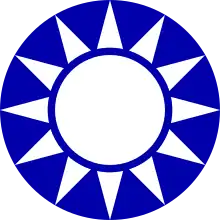CC Clique
The CC Clique (Chinese: CC派), or Central Club Clique (Chinese: 中央俱樂部組織), was one of the political factions within the Kuomintang (The Chinese Nationalist Party), in the Republic of China (1912–49). It was led by the brothers Chen Guofu and Chen Lifu, friends of Chiang Kai-shek.
Chen Lifu and his older brother Chen Guofu were nephews of Chen Qimei, who until his assassination by the Chinese warlord Yuan Shikai in 1916 was the mentor of upcoming Nationalist leader Chiang Kai-shek. The Chen brothers established the CC clique within the KMT.[1]: 138
Considered to be the extreme right of the Kuomintang alongside the Blue Shirts Society, the CC Clique represented traditionalists, anti-Communists, anti-Japanese and land interests. They stood closest to Generalissimo Chiang Kai-shek, influencing appointments and promotions, and held the largest block of votes in the Central Executive Committee. Chen Lifu was considered the party head. Its members included many of the elite within the party, including such people as Chiang Kai-shek's wife Soong Mei-ling and H.H. Kung. They influenced intelligence, trade, banking, the military, education, and propaganda.
The CC Clique placed loyal followers throughout the party and the government machinery, ensuring influence in the bureaucracy, educational agencies, youth organization and labor unions. The brothers also influenced the KMT's Central Bureau of Investigation and Statistics, one of Chiang's two main police and intelligence bodies. Chen Lifu freely admitted that these units caused considerable criticism (The Storm Clouds, p. 68).
The Gexin movement included many younger KMT members associated with the CC Clique.[1]: 138
The CC Clique aggressively criticized T.V. Soong following the Nationalist government's worsening economic crisis in January and early February 1947.[1]: 138 As Soong's political role receded, the CC Clique increased its economic influence, particularly in the Agricultural Bank of China, for which Chen Guofu had become the chairman of the board in 1945.[1]: 141 With Soong's influence decreased, CC Clique member Juo Jinghua aggressively developed commercial enterprises tied to the Clique.[1]: 141
Notable members
Wang Tseng-shan, a Chinese Muslim, was the KMT commissioner of Civil Affairs in the Xinjiang Coalition Government from 1946–47, and was associated with the CC Clique. The Uyghur Masud Sabri was also a CC Clique member, as was the Tatar Burhan Shahidi and the KMT-general and Han Chinese Wu Zhongxin.[2]
References
- Coble, Parks M. (2023). The Collapse of Nationalist China: How Chiang Kai-shek Lost China's Civil War. Cambridge New York, NY: Cambridge University Press. ISBN 978-1-009-29761-5.
- Andrew D. W. Forbes (1986). Warlords and Muslims in Chinese Central Asia: a political history of Republican Sinkiang 1911–1949. Cambridge, England: CUP Archive. pp. 199, 247, 253. ISBN 0-521-25514-7. Retrieved 2010-06-28.
Literature
- Wakeman, Frederic E. (2003). "Ideological Rivalries: The Blue Shirts and the "CC" Clique". In Wakeman, Frederic (ed.). Spymaster: Dai Li and the Chinese Secret Service. Berkeley (CA): University of California Press. pp. 98–109. doi:10.1525/california/9780520234079.003.0009. ISBN 9780520234079.
